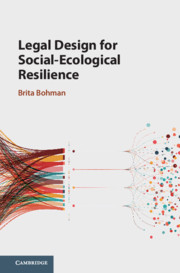Book contents
- Legal Design for Social-Ecological Resilience
- Legal Design for Social-Ecological Resilience
- Copyright page
- Contents
- Preface and Acknowledgments
- Table of Treaties and International Instruments
- Table of EU Law
- Table of Cases
- Abbreviations
- 1 Introduction
- 2 Environmental Law
- 3 Law and Governance
- 4 Defining Features for Resilience Governance
- 5 Adaptivity, Flexibility and Transformability
- 6 Multidimensional and Polycentric Structures
- 7 Stakeholders and Structures for Participation
- 8 Operationalization, Monitoring, Compliance and Trust Building
- 9 Conclusions – Effective Legal Design for Resilience Governance
- References
- Index
9 - Conclusions – Effective Legal Design for Resilience Governance
Published online by Cambridge University Press: 10 March 2021
- Legal Design for Social-Ecological Resilience
- Legal Design for Social-Ecological Resilience
- Copyright page
- Contents
- Preface and Acknowledgments
- Table of Treaties and International Instruments
- Table of EU Law
- Table of Cases
- Abbreviations
- 1 Introduction
- 2 Environmental Law
- 3 Law and Governance
- 4 Defining Features for Resilience Governance
- 5 Adaptivity, Flexibility and Transformability
- 6 Multidimensional and Polycentric Structures
- 7 Stakeholders and Structures for Participation
- 8 Operationalization, Monitoring, Compliance and Trust Building
- 9 Conclusions – Effective Legal Design for Resilience Governance
- References
- Index
Summary
In order to make the concept of social-ecological resilience and resilience governance comprehensible in a legal context the study first established some general governance features that represents the core of resilience governance. These features are the core of what a legal design for social-ecological resilience should reflect. However, law must also safe guard the legal principles and legal characteristics of law and its role as a stable institutional base with binding requirements. The study reviewed both possible matches and potential obstacles where law may not sufficiently reflect resilience governance. However, it also unveiled legal mechanisms that contributes in other ways than expected. All in all, a general conclusion is that law has many important features that matches resilience governance and thus has the potential to form an important basis for resilience governance in many different settings.
- Type
- Chapter
- Information
- Legal Design for Social-Ecological Resilience , pp. 204 - 213Publisher: Cambridge University PressPrint publication year: 2021

